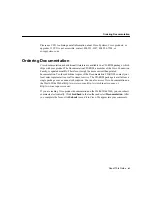
Preparing to Install the Router 2-5
Site Environment
Site Environment
The router can be placed on a desktop or mounted in a rack or on a wall. The location of
the chassis and the layout of your equipment rack or wiring room are extremely important
for proper system operation. Placing equipment too close together, inadequate ventilation,
and inaccessible panels can make system maintenance difficult or cause system
malfunctions and shutdowns.
When planning your site layout and equipment locations, remember the precautions
described in the next section, “Preventive Site Configuration.” If you are experiencing
shutdowns or unusually high errors with your existing equipment, these precautions might
help you isolate the cause of failures and prevent future problems.
Preventive Site Configuration
The following precautions will help you plan an acceptable operating environment for your
router and help you avoid environmentally-caused equipment failures:
•
Ensure that the room in which you operate your system has adequate air circulation.
Electrical equipment generates heat. Ambient air temperature might not be able to cool
equipment to acceptable operating temperatures without adequate circulation.
•
Always follow the ESD-prevention procedures described in the “Preventing
Electrostatic Discharge Damage” section on page 2-4 to avoid damage to equipment.
Damage from static discharge can cause immediate or intermittent equipment failure.
•
Ensure that the chassis cover is secure. The chassis is designed to allow cooling air to
flow effectively inside it. An open chassis allows air leaks, which might interrupt and
redirect the flow of cooling air from internal components.
Configuring Equipment Racks
The following information will help you plan an acceptable equipment rack configuration:\
•
Enclosed racks must have adequate ventilation. Ensure that the rack is not overly
congested because each unit generates heat. An enclosed rack should have louvered
sides and a fan to provide cooling air.















































